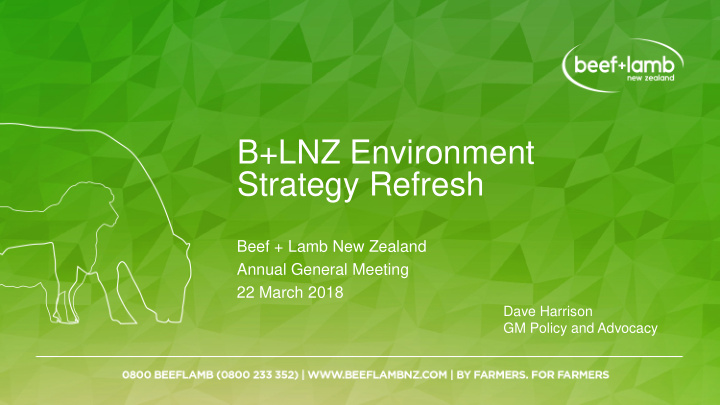



B+LNZ Environment Strategy Refresh Beef + Lamb New Zealand Annual General Meeting 22 March 2018 Dave Harrison GM Policy and Advocacy
A Little Bit of Process…. • Developed a set of aspirational goals • Environment Reference Group • ‘By 2040, we will have…..’ • Tested aspirational goals with farmers • Support for the idea, but… • Where are we now, and what can we practically do? • Draft strategy based around four pillars – water, GHGs, biodiversity and soils • Discussing with stakeholders • Moving to finalisation and implementation
Environment Strategy Four Focus Areas • Four key areas of activity • Cleaner Water • ‘New Zealanders can gather food and swim in freshwater surrounding our farms’ • Towards Carbon Neutral • ‘ 50% reduction in net emissions (below 1990 levels) by 2050’ • Thriving Biodiversity • ‘Sheep and beef farms provide…habitats that support biodiversity and protect our native species’ • Healthy Soils • ‘Land use is closely matched to soil potential’
Environment Strategy Our Approach • Our approach to improvement • ‘It starts with the individual farmer’ • Updated farm environment planning • Measuring and developing tools • ‘Scaling up for impact’ • Supporting groups of farmers to work together • Supporting farmer advocacy • Regional and national planning • Telling our story
Cleaner Water What Next? • Second Generation FEP • Focus on critical source areas, not blanket rules • All sheep and beef farms to have an FEP • Demonstrate link between action and outcome • Modelling tools – e.g., LUCI, Mitigator • Support for Catchment Groups
Cleaner Water Wharekopae Example • E-coli from sheep and beef farms affecting ‘swimmability’ • 2015: Gisborne District Council and B+LNZ team up • Workshops, case studies, research, monitoring • All 21 sheep and beef farmers in catchment have FEP • 4.2km of fencing • Alternatives to fencing • Fewer ‘unswimmable’ days • MfE Green Ribbon finalist
Towards Carbon Neutral What Next? • Advocate for recognition of our existing and future potential contribution • 19% below 1990 levels already • Emissions Trading Scheme policies • ‘1 billion trees’ policy • Overseer files for B+LNZ survey farms • Develop decision support tool
Thriving Biodiversity What Next? • Telling the story of biodiversity on sheep and beef farms • Improved biodiversity component to FEP • Working with farmers and others (e.g., DoC) on how to make best use of the resource we have • Biodiversity corridors? • Collectively managing areas of biodiversity?
Thriving Biodiversity Native Vegetation in New Zealand • Native vegetation on sheep and beef farms ~2.7 million ha • Sheep and beef farms contain 24% of native vegetation in NZ • 53% of native vegetation in Gisborne region is on S&B farms
Healthy Soils What Next? • Better understand our soils and land use capability • Natural capital approach to land management through FEPs • Targeted extension to reduce sediment loss from risk activities (e.g., intensive winter grazing)
Recommend
More recommend